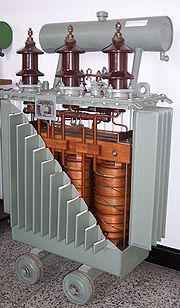A transformer is an electrical device that transfers energy between two or more circuits through electromagnetic induction.

A varying current in the transformer's primary winding creates a varying magnetic flux in the core and a varying magnetic field impinging on the secondary winding. This varying magnetic field at the secondary induces a varying electromotive force (EMF) or voltage in the secondary winding. Making use of Faraday's Law in conjunction with high magnetic permeability core properties, transformers can thus be designed to efficiently change AC voltages from one voltage level to another within power networks.
Transformers range in size from RF transformers less than a cubic centimetre in volume to units interconnecting the power grid weighing hundreds of tons. A wide range of transformer designs is encountered in electronic and electric power applications. Since the invention in 1885 of the first constant potential transformer, transformers have become essential for the AC transmission, distribution, and utilization of electrical energy.[3]
History of Transformer
The history of transformer was commenced in the year 1880. In the year 1950, 400KVelectrical power transformer was introduced in high voltage electrical power system. In the early 1970s, unit rating as large as 1100MVA was produced and 800KV and even higher KV class transformers were manufactured in year of 1980.
Cooling[]
To place the cooling problem in perspective, the accepted rule of thumb is that the life expectancy of insulation in all electric machines including all transformers is halved for about every 7 °C to 10 °C increase in operating temperature, this life expectancy halving rule holding more narrowly when the increase is between about 7 °C to 8 °C in the case of transformer winding cellulose insulation.[66][67][68]
Small dry-type and liquid-immersed transformers are often self-cooled by natural convection and radiation heat dissipation. As power ratings increase, transformers are often cooled by forced-air cooling, forced-oil cooling, water-cooling, or combinations of these.[69] Large transformers are filled with transformer oil that both cools and insulates the windings.[70] Transformer oil is a highly refined mineral oil that cools the windings and insulation by circulating within the transformer tank. The mineral oil and paper insulation system has been extensively studied and used for more than 100 years. It is estimated that 50% of power transformers will survive 50 years of use, that the average age of failure of power transformers is about 10 to 15 years, and that about 30% of power transformer failures are due to insulation and overloading failures.[71][72]Prolonged operation at elevated temperature degrades insulating properties of winding insulation and dielectric coolant, which not only shortens transformer life but can ultimately lead to catastrophic transformer failure.[66] With a great body of empirical study as a guide, transformer oil testing including dissolved gas analysis provides valuable maintenance information. This underlines the need to monitor, model, forecast and manage oil and winding conductor insulation temperature conditions under varying, possibly difficult, power loading conditions.[73][74]
Building regulations in many jurisdictions require indoor liquid-filled transformers to either use dielectric fluids that are less flammable than oil, or be installed in fire-resistant rooms.[37] Air-cooled dry transformers can be more economical where they eliminate the cost of a fire-resistant transformer room.
The tank of liquid filled transformers often has radiators through which the liquid coolant circulates by natural convection or fins. Some large transformers employ electric fans for forced-air cooling, pumps for forced-liquid cooling, or have heat exchangers for water-cooling.[70] An oil-immersed transformer may be equipped with a Buchholz relay, which, depending on severity of gas accumulation due to internal arcing, is used to either alarm or de-energize the transformer.[56] Oil-immersed transformer installations usually include fire protection measures such as walls, oil containment, and fire-suppression sprinkler systems.
Polychlorinated biphenyls have properties that once favored their use as a dielectric coolant, though concerns over their environmental persistence led to a widespread ban on their use.[75] Today, non-toxic, stable silicone-based oils, or fluorinated hydrocarbons may be used where the expense of a fire-resistant liquid offsets additional building cost for a transformer vault.[37][76] PCBs for new equipment were banned in 1981 and in 2000 for use in existing equipment in United Kingdom[77] Legislation enacted in Canada between 1977 and 1985 essentially bans PCB use in transformers manufactured in or imported into the country after 1980, the maximum allowable level of PCB contamination in existing mineral oil transformers being 50 ppm.[78]
Some transformers, instead of being liquid-filled, have their windings enclosed in sealed, pressurized tanks and cooled by nitrogen or sulfur hexafluoride gas.[76]
Experimental power transformers in the 500‐to‐1,000 kVA range have been built with liquid nitrogen or helium cooled superconducting windings, which eliminates winding losses
without affecting core losses.[79][80]



